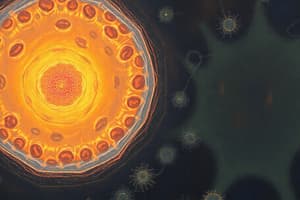Podcast
Questions and Answers
What defines eukaryotic organisms in terms of cell structure?
What defines eukaryotic organisms in terms of cell structure?
- Circular DNA without histones
- Presence of membrane-bound organelles (correct)
- Smaller cell size compared to prokaryotes
- Lack of a defined nucleus
Which method of reproduction is predominant in prokaryotic organisms?
Which method of reproduction is predominant in prokaryotic organisms?
- Mitosis
- Fragmentation
- Binary fission (correct)
- Meiosis
What is the main composition of genetic material in prokaryotic cells?
What is the main composition of genetic material in prokaryotic cells?
- Ring-shaped RNA
- Linear DNA associated with histones
- Circular DNA not associated with histones (correct)
- Multiple linear chromosomes
Which ribosome size is characteristic of eukaryotic cells?
Which ribosome size is characteristic of eukaryotic cells?
Which of the following organisms is classified as prokaryotic?
Which of the following organisms is classified as prokaryotic?
What is a key feature of eukaryotic cell metabolism?
What is a key feature of eukaryotic cell metabolism?
What is the size range of prokaryotic cells?
What is the size range of prokaryotic cells?
Which structure is commonly associated with the cell walls of eukaryotes?
Which structure is commonly associated with the cell walls of eukaryotes?
Flashcards are hidden until you start studying
Study Notes
Diferencias Entre Eucariotas Y Procariotas
-
Definición:
- Eucariotas: Organismos cuyas células tienen un núcleo definido y organelos membranosos.
- Procariotas: Organismos cuyas células no tienen núcleo definido ni organelos membranosos.
-
Estructura celular:
- Eucariotas:
- Células más grandes y complejas (10-100 micrómetros).
- Núcleo rodeado por una membrana nuclear.
- Organelos como mitocondrias, retículo endoplasmático, aparato de Golgi.
- Procariotas:
- Células más pequeñas y simples (0.1-5 micrómetros).
- Material genético disperso en el citoplasma (nucleoide).
- Sin organelos membranosos.
- Eucariotas:
-
Reproducción:
- Eucariotas:
- Reproducción sexual y asexual.
- Mitósis y meiosis para la división celular.
- Procariotas:
- Principalmente reproducción asexual (fisión binaria).
- No realizan mitosis ni meiosis.
- Eucariotas:
-
Material genético:
- Eucariotas:
- ADN lineal, asociado a histonas.
- Puede haber múltiples cromosomas.
- Procariotas:
- ADN circular, no asociado a histonas.
- Generalmente un solo cromosoma.
- Eucariotas:
-
Ribosomas:
- Eucariotas:
- Ribosomas más grandes (80S).
- Procariotas:
- Ribosomas más pequeños (70S).
- Eucariotas:
-
Ejemplos:
- Eucariotas: Animales, plantas, hongos, protistas.
- Procariotas: Bacterias y arqueas.
-
Pared celular:
- Eucariotas: Presente en plantas (celulosa) y hongos (quitina), ausente en animales.
- Procariotas: Composición variada (peptidoglucano en bacterias).
-
Metabolismo:
- Eucariotas: Mayor diversidad metabólica, incluyendo fotosíntesis en algunos.
- Procariotas: Métodos metabólicos variados, incluyendo anaerobios y quimiosintéticos.
-
Organización:
- Eucariotas: Generalmente multicelulares o unicelulares.
- Procariotas: Generalmente unicelulares.
-
Ejemplos de función:
- Eucariotas: Especialización de células y tejidos en organismos multicelulares.
- Procariotas: Adaptabilidad a diversos ambientes y condiciones extremas.
Definitions
- Eukaryotes: Organisms with defined nuclei and membrane-bound organelles.
- Prokaryotes: Organisms lacking a defined nucleus and membrane-bound organelles.
Cellular Structure
- Eukaryotic cells are larger (10-100 micrometers) and more complex.
- Eukaryotes have a nucleus surrounded by a nuclear membrane and organelles like mitochondria and Golgi apparatus.
- Prokaryotic cells are smaller (0.1-5 micrometers) and simpler.
- Prokaryotic genetic material is located in the cytoplasm (nucleoid) and lacks membrane-bound organelles.
Reproduction
- Eukaryotes can reproduce both sexually and asexually, using mitosis and meiosis for cell division.
- Prokaryotes primarily reproduce asexually by binary fission, with no mitosis or meiosis.
Genetic Material
- Eukaryotic DNA is linear and associated with histones, typically has multiple chromosomes.
- Prokaryotic DNA is circular, not associated with histones, and generally consists of a single chromosome.
Ribosomes
- Eukaryotic ribosomes are larger (80S).
- Prokaryotic ribosomes are smaller (70S).
Examples
- Eukaryotes include animals, plants, fungi, and protists.
- Prokaryotes consist of bacteria and archaea.
Cell Wall Composition
- Eukaryotes have a cell wall in plants (cellulose) and fungi (chitin) but none in animals.
- Prokaryotic cell walls have varied compositions, with peptidoglycan present in bacteria.
Metabolism
- Eukaryotes exhibit greater metabolic diversity, including photosynthesis in some species.
- Prokaryotes display a wide range of metabolic methods, including anaerobic and chemosynthetic processes.
Organization
- Eukaryotes can be multicellular or unicellular.
- Prokaryotes are primarily unicellular.
Functional Examples
- Eukaryotes feature specialization of cells and tissues in multicellular organisms.
- Prokaryotes demonstrate adaptability to various environments and extreme conditions.
Studying That Suits You
Use AI to generate personalized quizzes and flashcards to suit your learning preferences.




